Lancaster played a pivotal role in American history. Today, the former homes and hangouts of those who shaped the nation exist alongside contemporary shops and restaurants that are breathing new life into one of the United States’ oldest cities.
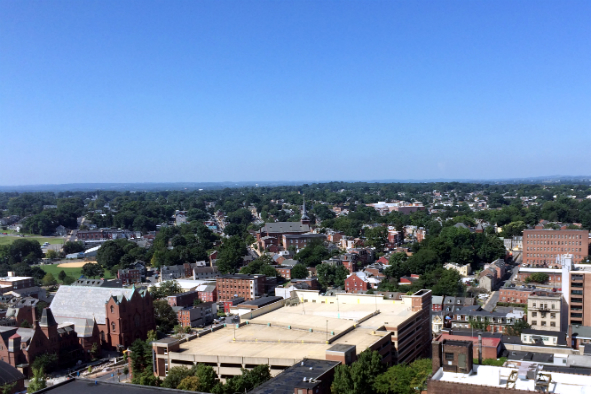
A rooftop view of downtown Lancaster, Pennsylvania (Photo: Wendy Fontaine)
On a warm and wet Sunday evening in downtown Lancaster, as fresh rain begins to evaporate from the stone sidewalks, a woman wearing dark denim cutoffs and a white midriff stomps down King Street, toward one of the only pubs still open. It’s early, barely even 8 p.m., but most of the shops and restaurants in town have already closed. Many have been closed all day. This corner of southeastern Pennsylvania is perhaps best known for its Amish population, which observes a strict no-work, no-shopping policy on Sundays. In a hurry, the woman checks for oncoming traffic — there isn’t much — and crosses the street, eyeing a small group on a haunted history walking tour. She glances at her Smartphone and flicks her long, blonde hair away from her face, revealing black eyeliner and multiple piercings, a stark contrast to the town’s reputation for tradition.
Signs of downtown Lancaster’s conventional heritage are everywhere, from the architecture and the monuments to the shape and configuration of the streets. Incorporated during the American Revolutionary War, the town was frequented by various dignitaries, including men who would eventually become presidents. But interspersed in this history are also signs of a generational shift. Vegan joints nestle between locations named after famous former residents, like James Buchanan and Thaddeus Stevens. Horse-drawn buggies still make their way down these roads and alleyways, alongside hybrid cars and Uber drivers.
Here in Lancaster, multiple worlds converge. Yet, there seems to be room for everyone.
Shopping
In the middle of Penn Square, the towering granite Soldiers and Sailors Monument honors Union soldiers killed during the Civil War. From there, the streets of Lancaster spread out like a grid (Philadelphia was the first city in America to use a grid design system, setting precedence for other colonial towns), with each neighborhood offering its own blend of old and new.
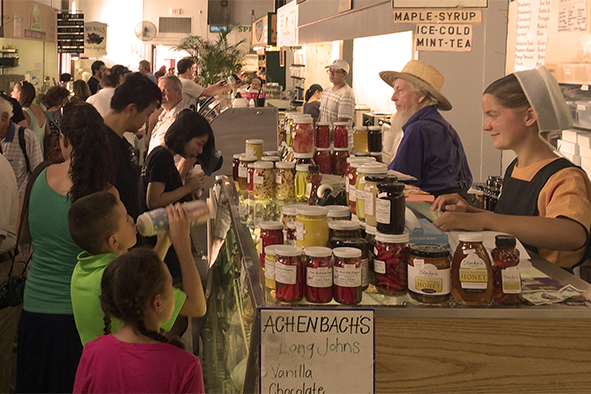
Shoppers stock up on honey, maple syrup, hot peppers and other canned goods from an Amish vendor inside Central Market, the nation’s oldest farmers’ market (Photo: Wendy Fontaine)
The focal point of downtown Lancaster may be Central Market (23 North Market Street) at Penn Square, a large, Romanesque Revival-style brick building where Amish farmers and their families still deliver fresh vegetables and handmade goods three days a week (Tuesday, Friday and Saturday). The market has been ongoing since the 1700s, when King George officially designated Lancaster a market town — meaning it could legally operate as a trading center.
Though Amish are allowed to ride in automobiles, they are not allowed to own them. So on market day, you’ll find carriages with giant wagon wheels parked around the building, horses waiting patiently for their owners to return. The market itself is hot and crowded as shoppers weave their way through aisles of blueberries, heirloom tomatoes, peaches, apple dumplings, doughnuts, jams, pickles and more. There are more than sixty vendors, including bakers, butchers, fromagers, crafters and quilters — all of whom are happy to chat or offer free samples. As for local delicacies, two worth trying are whoopie pies, the chocolate cake-like cookies sandwiched with cream filling, and shoofly pie, made with brown sugar and molasses. Besides traditional fare, there are some unexpected treats inside Central Market, including crunchy coconut brittle, spanakopita and fresh Thai spring rolls.
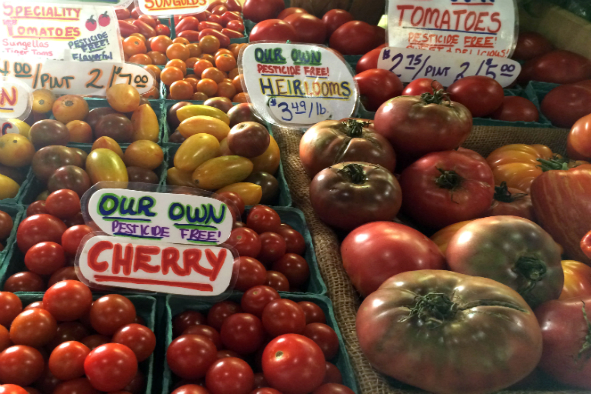
Sungold, Sungella and Tiger Tom’s are a few of the tomato varieties for sale at Central Market (Photo: Wendy Fontaine)
North Queen Street boasts a collection of funky shops, art galleries and consignment stores, all independently owned. Dwelling (356 N. Queen St.) sells quaint but sophisticated home décor, including charming recycled barn wood signs for interior and exterior.
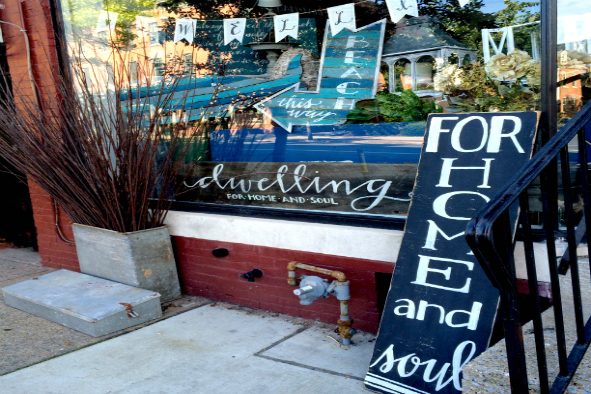
Dwelling, which sells handmade signs made of recycled barn wood, is one of many unique shops located in the 300 block of North Queen Street in downtown Lancaster (Photo: Wendy Fontaine)
Building Character (342 N. Queen St.) houses about 10,000 square feet of warehouse space chock-full of vintage clothes and toys, furniture, jewelry and salvaged goods. In this neighborhood, shopping is more like treasure hunting. Visitors should allot enough time for discoveries.
Food
Food options abound in Lancaster, which has experienced a gourmet renaissance in recent years. Even in the local cuisine, there is a merger of classic and contemporary.
For breakfast or lunch, Prince Street Café (151 N. Prince St.) is known for strong coffee and a twist on traditional comfort foods. Besides spicy breakfast burritos, the menu includes rice bowls with grilled chicken and avocado, a BLT with cream cheese, homemade baked oatmeal and a variety of smoothies, including mango, green tea and chai. With free wifi, this café attracts college students and local writers. Tables fill up fast.
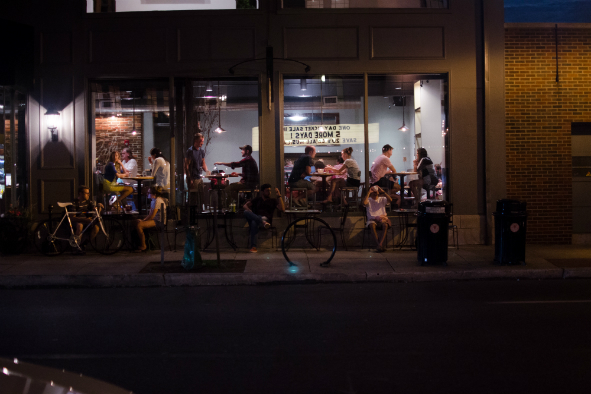
Prince Street Café is where locals tank up in downtown Lancaster (Photo: Zac Evans via Flickr)
For nontraditional fare, there’s Aussie and the Fox (38 W. King St.), which combines American and Australian cuisine. The menu changes frequently, but one thing that never changes is the Aussie burger, which comes with fried egg, red beet ketchup and pineapple mustard. The Mr. Fox Cocktail represents another Australian tradition: mixing coffee with alcohol. This drink combines cold brew coffee with vodka, simple syrup and lavender bitters.
Issei Noodle (44 N. Queen St.) makes traditional Vietnamese fare. One popular dish is the pho (pronounced “fuh”), which is rich salty broth with rice noodles, cilantro, bean sprouts, lime and your choice of chicken, shrimp or beef. Keep an eye out for discount days.
Lately, locals are buzzing about Sprout (58 N. Prince St.), where the specialty is bánh mì — a Vietnamese sandwich filled with ham, chicken or pork, along with shredded carrot, radish, cucumber and jalapeño. Another popular treat is their macaroons — the French meringue cookies made with almond flour and egg whites. This menu surprise is perhaps a tribute to the owners’ former life in New Orleans, where the family lived until they evacuated to central Pennsylvania after Hurricane Katrina.
With the recent closure of The Seed, local vegans are hanging out at Root (223 W. Walnut St.), a former brewery that specializes in animal-free fare. The menu includes comfort foods like spicy gumbo with okra, tomatoes and oyster mushrooms, as well as fusion dishes like Korean barbecue jackfruit tacos. Even the wine and beer selections are vegan-friendly, since many types of alcohol use animal proteins to reduce astringency.
Dinner and Drinks
The Pressroom (26-28 W. King St.) is a casual bistro in an 18th-century building, newly renovated to include an outdoor bar with courtyard seating. Inside, the printing-press motif is a nod to the media group that owns the restaurant and publishes the local newspaper. If weather permits, though, sit outside near the waterfall and order a pizza and a bunch of small plates, like beef empanadas, risotto balls with pesto aioli, or duck fat gravy fries.
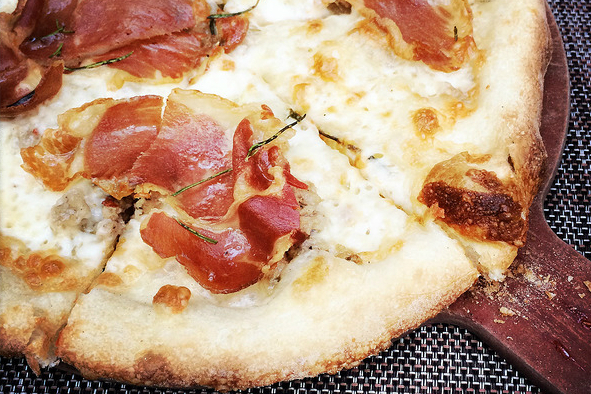
Mmmm….pizza at the Press Room (Photo: Steam Pipe Trunk Distribution Venue via Flickr)
For something meaty and comforting, there’s Annie Bailey’s Irish Pub & Restaurant (28 E. King St.), where the shepherd’s pie is loaded with beef and lamb and topped with cheesy potatoes. Fair warning: the hearty size is enough for three people. In the summer, the pub serves alcoholic ice pops. In the winter, Blood Marys made with house-infused vodka are popular.
Still a working restaurant, The Lancaster Dispensing Co. (35 N. Market St.), known locally as “the dipco,” used to be a hotel and tavern occasionally frequented by George Washington’s continental soldiers on their way to Philadelphia (Washington himself reportedly visited Lancaster five times). Now, the authentic Victorian-style pub hosts live music and offers a vast, affordable menu — from sandwiches and burgers to larger entrees, like chicken with apples and Cajun-cream linguini. The dipco is known for its beer selection, but one cocktail you won’t find anyplace else is the Tall, Dark and Handsome, a martini made with vanilla vodka, butterscotch schnapps and dark crème de cacao.
The center of nightlife in Lancaster is Tellus360 (25 N. King St.), a complex that includes a whiskey bar with more than 200 varieties of spirit, a basement speakeasy and a rooftop club where DJs blast dance music on the weekends. You’ll also find performances by local musicians, story slam events and traditional Irish jam sessions.
A Taste of History
Lancaster is saturated with American history. It was the nation’s capital for a day when the Continental Congress fled from the British invasion of Philadelphia in 1777. It was also home to George Ross, an original signer of the Declaration of Independence and the uncle of Betsy Ross, the creator of the first American flag. The clerk who actually wrote the Declaration — Timothy Matlack, known for his perfect penmanship — lived here too, on East Orange Street. A trip to Lancaster would not be complete without tapping into this rich history.
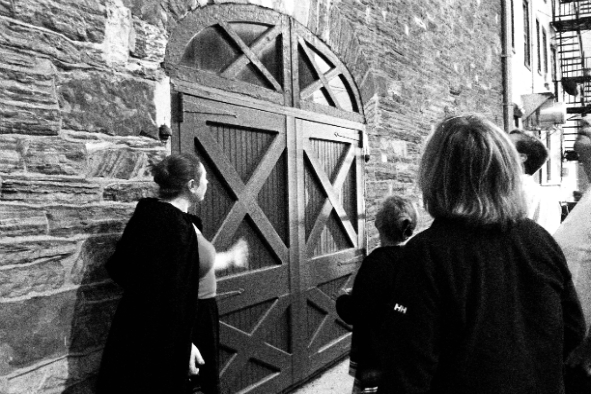
Ghost tour guide Jennifer Angstadt, left, leads visitors on a walk to some of Lancaster’s reportedly haunted locations, including the old jail – site of the Conestoga Indian tribe massacre in December 1763 (Photo: Wendy Fontaine)
For a fun twist on learning about old events, Ghost Tours of Lancaster (25 S. Queen St.) runs evening excursions to the town’s spookiest locations, like the Fulton Opera House, where Abraham Lincoln’s assassin John Wilkes Booth performed as an actor. It’s not Booth who allegedly makes trouble at the opera house, though. According to local legend, theatergoers have reported seeing an apparition in white near the stage. The apparition, some say, is Mary Cahill, an actress known for her diva-like attitude and a penchant for wearing white gowns. Another stop on the tour is the dipco. On particularly cold nights in winter, some claim to hear bells, horse hooves and wagon wheels moving over the brick street. The sounds carry toward Central Market, which once housed the town’s fire company.
Whether there’s any truth to the spooky stories, the 90-minute walking tours are more educational than scary, as a well-informed guide with a lantern leads the group through the streets of Lancaster, from the former city hall building to the old jailhouse and over to the Saint James Episcopal Church Cemetery on Duke Street. The guide works from a memorized script, but she cannot be stumped. Her knowledge of local history, from the antics of bachelor President James Buchanan to the 1763 massacre of the Conestoga Indians, is extensive.
Another venture into American history lies just outside of Lancaster proper, where the landscape is dotted with church steeples, farms, silos, and Amish buggies. Seven minutes from downtown Lancaster is Wheatland (1120 Marietta Ave.), the Federal-style home of former President James Buchanan. On the National Register of Historic Places and open for tours, Wheatland offers a glimpse into the private life of a man not fondly remembered by history. Buchanan presided over a deeply divided nation, as tensions mounted between the North and South leading up to the Civil War. Buchanan sided with the South regarding slavery, saying it was a moral issue that should be decided by the states rather than the federal government. He left office in 1861 without seeking a second term and was replaced by Abraham Lincoln. Shortly after, the nation was at war.
Inside Buchanan’s mansion, table settings and desks are just as they might have been in 1860, as though the president has only stepped out for a moment. The property has never been significantly remodeled, meaning many of the features inside the home – including the carpets and a bell system to beckon the servants – are original. From the green shutters and lunette windows to the door knockers embossed with the president’s family name, Wheatland is an unmitigated depiction of how things used to be in Lancaster in the late 19th century, before Progressivism and millennials began to make their mark.